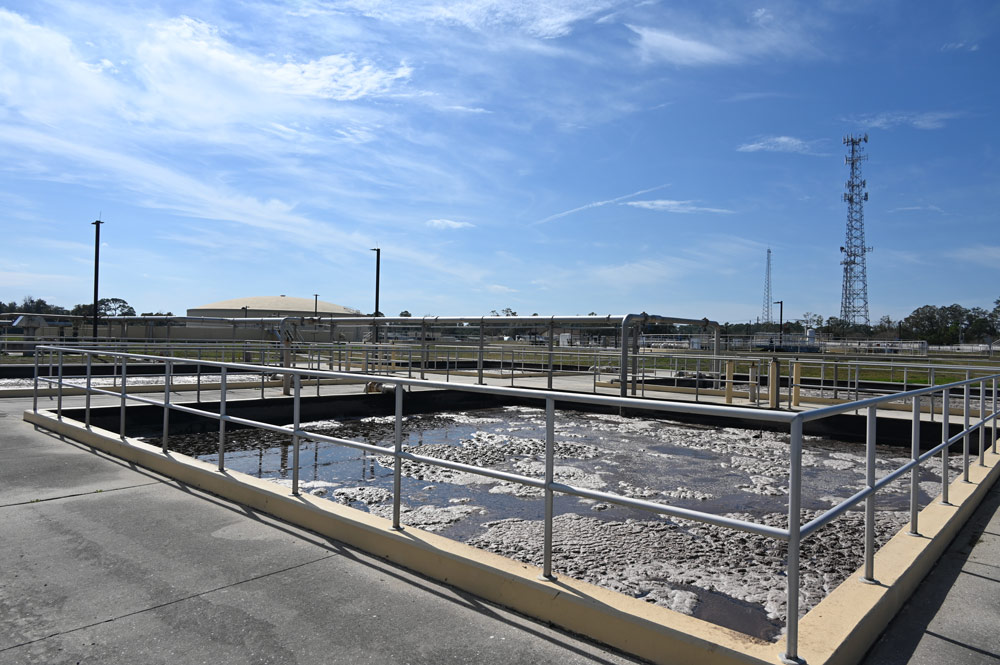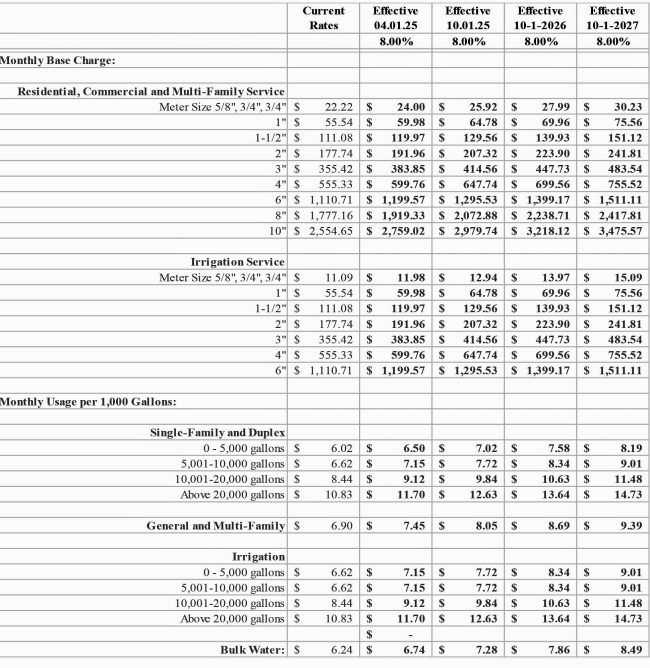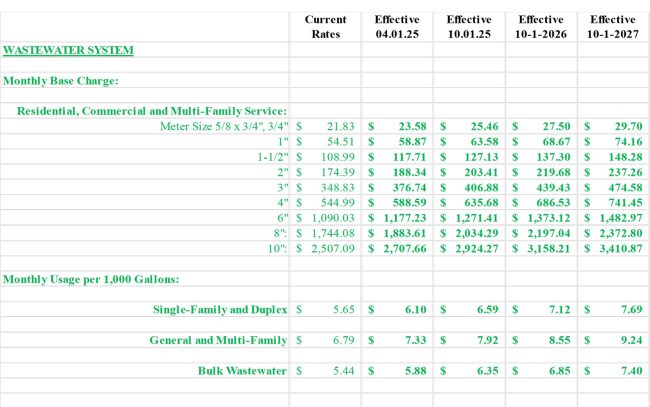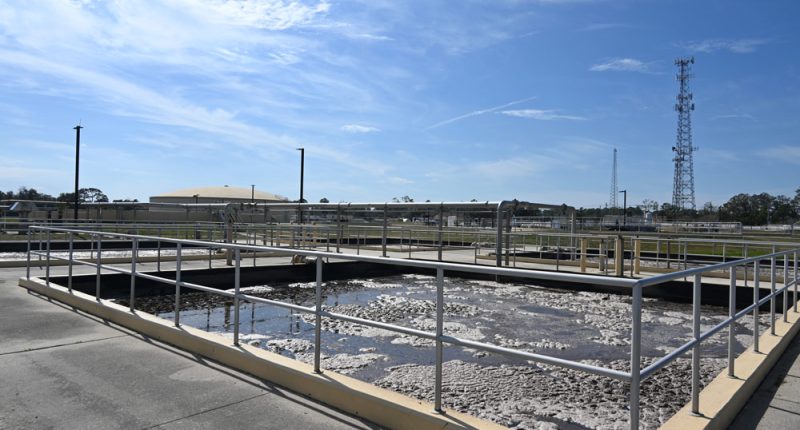
A consultant is recommending that Palm Coast government raise water rates 36 percent and sewer rates 30.5 percent over a mere 20 months–from April this year to Jan. 1, 2027–if the city’s utility infrastructure is to keep up with demand, expand and upgrade existing facilities, and keep up with debt obligations. If enacted, it would be the steepest rate increase in the shortest time span in the city’s history, a reflection of the strains Palm Coast’s water and sewer infrastructure is operating under.
The bottom line recommendation for residents of single-family homes: the base water rate and the consumption rate would each rise 36 percent by Jan. 1, 2027, in 8 percent increments split between April 2025 and January 1, 2027. Similarly, the base sewer rate and consumption rate–what goes down the drain and the toilet–would each rise by 30.5 percent.
Water and sewer rates are calculated separately on consumers’ bills.
In actual dollars, the base water rate would go from $22.22 to $30.23 in that time span. Everyone pays the same base rate. Everyone pays a usage, or consumption fee, too, but consumption differs from household to household. The more residents and businesses consume water, the higher the usage fee. That’s designed to encourage conservation.
So if your household uses 4,000 gallons a month, its water bill would go from $46.30 to $63 by 2027, a monthly difference of $16.7, or $200 a year compared with current rates. The sewer portion of the bill would go from $44.43 currently to $60.46 by 2027, a difference of $16.03 per month, or $192 per year. Combining water and sewer, that bill would go from $90.73 today to $123.46, a difference of $32.73, or $393 per year.
A household using 5,000 to 10,000 gallons a month would see water rates go from $6.62 a month per 1,000 gallons to $9.01 per 1,000 gallons by 2027, for a total monthly bill of $48.7 currently to $66.27 in 2027, a difference of $17.57 per month, or $211 a year. The sewer portion would be the same as for households with less consumption, so the total bill would be $93.13 today, compared to $126.73 in 2027, a difference of $33.60 per month, or $403 for the year.
If your household uses 11,000 gallons, the per-1,000-gallon charge for water would go from $8.44 to $11.48, with the same base fee increase from 22.22 to $30.23, so the bill would go from $115 today to $156.51 in 2027, a difference of $41.51 per month, or just under $500 for the year. Add in the sewer rate, and the bill totals $159.43 at today’s rates, going up to $217, a difference of $57.57 per month, or $691 per year, which is close to what some households pay in Palm Coast property taxes.
Different rate schedules apply for private fire protection services that depend on city water, for irrigation water, for apartments and for bulk water. (See some of the charts below, or at the very end of the document embedded at the foot of the article for the full details.)
Here’s the proposed rate schedule for water:

Here’s the proposed rate schedule for sewer:

Those rates appear on customers’ utility bills, which also include the monthly stormwater rate, currently $32.87, and the monthly garbage rate, $33.30, all of which will continue to rise. In 2023, the council approved a 75 percent increase in the stormwater rate, spread over five years. By 2028, residents will be paying $39.10 a month in stormwater fees. (In 2012, the stormwater fee was $8 a month.) The garbage rate is indexed to inflation.
The city hired Stantec Consulting Services Inc., a global consultancy, to study Palm Coast’s utility system, determine capital needs and calculate necessary revenue to pay for that. The system generates revenue two ways: rate-payers and impact fees, the one-time fee builders and developers pay to connect a house or a business to utilities. The consultant presented its preliminary results in November 2023, recommending, alongside city staffers, a rate increase back then. The consultant’s message was simple: residents must assume the cost of growth, because future growth alone won’t do it.
Residents were not happy. The council was not happy. A City Council with three members facing elections agreed to raise impact fees but not water and sewer rates, essentially deferring the tough decision. (See: “Council Votes 4-1 to Keep Current Palm Coast Water and Sewer Rates While Raising Development Fees 30%.”)
All three council members lost their elections. The only council member who was on the board at the time and remains on it now is Theresa Pontieri, who had also supported the split approach and asked for more details and options on rate structures, knowing even then that the council would not–could not–delay rate increases much longer. Bromides aside, the City Council’s primary obligation, when it comes to its utility, is not to local residents or businesses, but to bond-holders. The city cannot afford to make bond-holders nervous about the soundness of the utility’s finances, especially as growth continues. (It was bondholder fretting that compelled a different council in 2011 to sharply increase its stormwater fees.)
That growth has been steep, almost returning between 2018 and 2024 to the unsustainable levels of the housing boom between 2001 and 2006: in 2023, the city issued more than 2,500 certificates of occupancy for housing units. Last year it was 2,000. The majority have been issued to existing lots platted by ITT, the founder and original developer of Palm Coast, not to new subdivisions, as the chart below indicates.

But growth alone is not the only driver of strain on the city’s infrastructure. On dry days, there is no issue at the utility. It is significantly under capacity. The strain and those over-capacity days are provoked by stormwater, not residential or business consumption, and by an aging infrastructure that causes what the city refers to as “inflow and infiltration.” That’s effluent that seeps into the system, whether through older pipes or older pep tanks, and ends up at the sewer plant.
The city has just two wastewater treatment plants and three water plants. The water plants are not under strain as the sewer plant, and more particularly Wastewater Treatment 1, in the Woodlands, the city’s oldest (ITT built it in 1971). It is at 99 percent capacity, and in any significant rain event, it is over capacity, sometimes by millions of gallons of waste or stormwater per day. That’s why it’s under a consent order by the state. That’s why the city can no longer defer paying for the necessary capacity expansion and infrastructure repairs.
It’s also why earlier this week an aide to Sen. Rick Scott toured the troubled sewer plant at the urging of Council member Charles Gambaro, who is hoping to line up state and federal grants to defray the steep costs ahead. The city seemed to be in line for a $35 million appropriation at the last legislative session, but lawmakers pared that down to $1 million in conference before the governor vetoed even that much.
The council will have that discussion at a workshop Tuesday. The summary of the rate study is below.
![]()
rate-study
![]()









